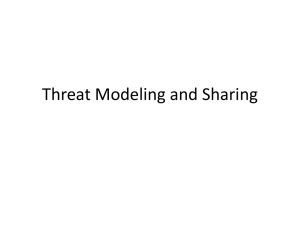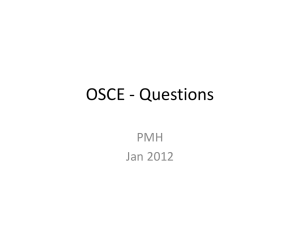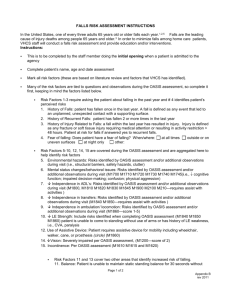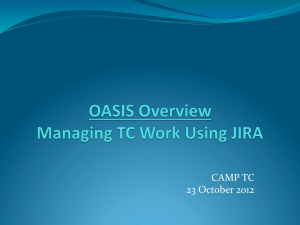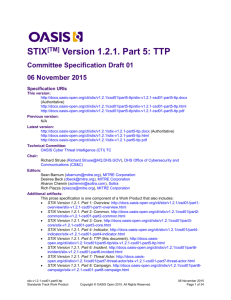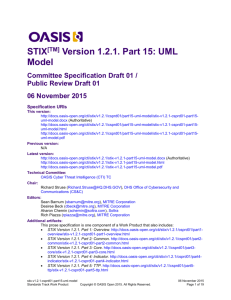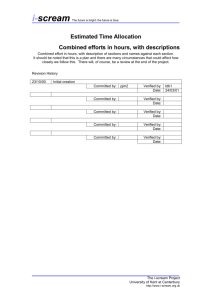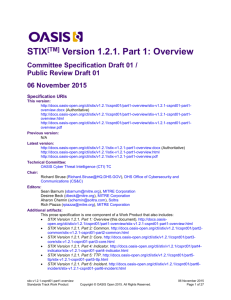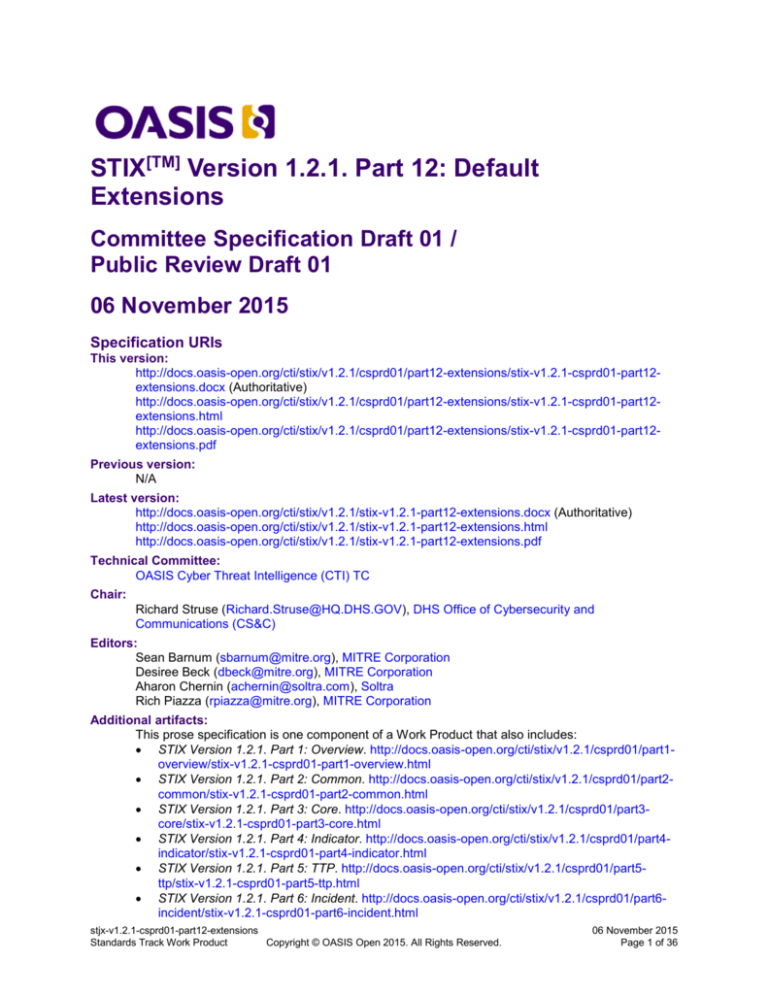
STIX[TM] Version 1.2.1. Part 12: Default
Extensions
Committee Specification Draft 01 /
Public Review Draft 01
06 November 2015
Specification URIs
This version:
http://docs.oasis-open.org/cti/stix/v1.2.1/csprd01/part12-extensions/stix-v1.2.1-csprd01-part12extensions.docx (Authoritative)
http://docs.oasis-open.org/cti/stix/v1.2.1/csprd01/part12-extensions/stix-v1.2.1-csprd01-part12extensions.html
http://docs.oasis-open.org/cti/stix/v1.2.1/csprd01/part12-extensions/stix-v1.2.1-csprd01-part12extensions.pdf
Previous version:
N/A
Latest version:
http://docs.oasis-open.org/cti/stix/v1.2.1/stix-v1.2.1-part12-extensions.docx (Authoritative)
http://docs.oasis-open.org/cti/stix/v1.2.1/stix-v1.2.1-part12-extensions.html
http://docs.oasis-open.org/cti/stix/v1.2.1/stix-v1.2.1-part12-extensions.pdf
Technical Committee:
OASIS Cyber Threat Intelligence (CTI) TC
Chair:
Richard Struse (Richard.Struse@HQ.DHS.GOV), DHS Office of Cybersecurity and
Communications (CS&C)
Editors:
Sean Barnum (sbarnum@mitre.org), MITRE Corporation
Desiree Beck (dbeck@mitre.org), MITRE Corporation
Aharon Chernin (achernin@soltra.com), Soltra
Rich Piazza (rpiazza@mitre.org), MITRE Corporation
Additional artifacts:
This prose specification is one component of a Work Product that also includes:
STIX Version 1.2.1. Part 1: Overview. http://docs.oasis-open.org/cti/stix/v1.2.1/csprd01/part1overview/stix-v1.2.1-csprd01-part1-overview.html
STIX Version 1.2.1. Part 2: Common. http://docs.oasis-open.org/cti/stix/v1.2.1/csprd01/part2common/stix-v1.2.1-csprd01-part2-common.html
STIX Version 1.2.1. Part 3: Core. http://docs.oasis-open.org/cti/stix/v1.2.1/csprd01/part3core/stix-v1.2.1-csprd01-part3-core.html
STIX Version 1.2.1. Part 4: Indicator. http://docs.oasis-open.org/cti/stix/v1.2.1/csprd01/part4indicator/stix-v1.2.1-csprd01-part4-indicator.html
STIX Version 1.2.1. Part 5: TTP. http://docs.oasis-open.org/cti/stix/v1.2.1/csprd01/part5ttp/stix-v1.2.1-csprd01-part5-ttp.html
STIX Version 1.2.1. Part 6: Incident. http://docs.oasis-open.org/cti/stix/v1.2.1/csprd01/part6incident/stix-v1.2.1-csprd01-part6-incident.html
stjx-v1.2.1-csprd01-part12-extensions
Standards Track Work Product
Copyright © OASIS Open 2015. All Rights Reserved.
06 November 2015
Page 1 of 36
STIX Version 1.2.1. Part 7: Threat Actor. http://docs.oasisopen.org/cti/stix/v1.2.1/csprd01/part7-threat-actor/stix-v1.2.1-csprd01-part7-threat-actor.html
STIX Version 1.2.1. Part 8: Campaign. http://docs.oasisopen.org/cti/stix/v1.2.1/csprd01/part8-campaign/stix-v1.2.1-csprd01-part8-campaign.html
STIX Version 1.2.1. Part 9: Course of Action. http://docs.oasisopen.org/cti/stix/v1.2.1/csprd01/part9-coa/stix-v1.2.1-csprd01-part9-coa.html
STIX Version 1.2.1. Part 10: Exploit Target. http://docs.oasisopen.org/cti/stix/v1.2.1/csprd01/part10-exploit-target/stix-v1.2.1-csprd01-part10-exploittarget.html
STIX Version 1.2.1. Part 11: Report. http://docs.oasis-open.org/cti/stix/v1.2.1/csprd01/part11report/stix-v1.2.1-csprd01-part11-report.html
STIX Version 1.2.1. Part 12: Default Extensions (this document). http://docs.oasisopen.org/cti/stix/v1.2.1/csprd01/part12-extensions/stix-v1.2.1-csprd01-part12-extensions.html
STIX Version 1.2.1. Part 13: Data Marking. http://docs.oasisopen.org/cti/stix/v1.2.1/csprd01/part13-data-marking/stix-v1.2.1-csprd01-part13-datamarking.html
STIX Version 1.2.1. Part 14: Vocabularies. http://docs.oasisopen.org/cti/stix/v1.2.1/csprd01/part14-vocabularies/stix-v1.2.1-csprd01-part14vocabularies.html
STIX Version 1.2.1. Part 15: UML Model. http://docs.oasisopen.org/cti/stix/v1.2.1/csprd01/part15-uml-model/stix-v1.2.1-csprd01-part15-uml-model.html
UML Model Serialization: http://docs.oasis-open.org/cti/stix/v1.2.1/csprd01/uml-model/
Related work:
This specification replaces or supersedes:
STIXTM 1.2 Default Extensions Specification
https://github.com/STIXProject/specifications/blob/version1.2/documents/pdf%20versions/STI
X_Extensions_Draft.pdf
This specification is related to:
CybOX[TM] Version 2.1.1. Work in progress. https://www.oasisopen.org/committees/tc_home.php?wg_abbrev=cti-cybox
CybOX[TM] 2.1. https://cyboxproject.github.io/
Abstract:
The Structured Threat Information Expression (STIX) framework defines nine core constructs and
the relationships between them for the purposes of modeling cyber threat information and
enabling cyber threat information analysis and sharing. This specification document defines the
default extensions for the STIX framework.
Status:
This document was last revised or approved by the OASIS Cyber Threat Intelligence (CTI) TC on
the above date. The level of approval is also listed above. Check the “Latest version” location
noted above for possible later revisions of this document. Any other numbered Versions and
other technical work produced by the Technical Committee (TC) are listed at https://www.oasisopen.org/committees/tc_home.php?wg_abbrev=cti#technical.
TC members should send comments on this specification to the TC’s email list. Others should
send comments to the TC’s public comment list, after subscribing to it by following the
instructions at the “Send A Comment” button on the TC’s web page at https://www.oasisopen.org/committees/cti/.
For information on whether any patents have been disclosed that may be essential to
implementing this specification, and any offers of patent licensing terms, please refer to the
Intellectual Property Rights section of the TC’s web page (https://www.oasisopen.org/committees/cti/ipr.php).
Citation format:
When referencing this specification the following citation format should be used:
[STIX-v1.2.1-Extensions]
stjx-v1.2.1-csprd01-part12-extensions
Standards Track Work Product
Copyright © OASIS Open 2015. All Rights Reserved.
06 November 2015
Page 2 of 36
STIX[TM] Version 1.2.1. Part 12: Default Extensions. Edited by Sean Barnum, Desiree Beck,
Aharon Chernin, and Rich Piazza. 06 November 2015. OASIS Committee Specification Draft 01 /
Public Review Draft 01. http://docs.oasis-open.org/cti/stix/v1.2.1/csprd01/part12-extensions/stixv1.2.1-csprd01-part12-extensions.html. Latest version: http://docs.oasisopen.org/cti/stix/v1.2.1/stix-v1.2.1-part12-extensions.html.
stjx-v1.2.1-csprd01-part12-extensions
Standards Track Work Product
Copyright © OASIS Open 2015. All Rights Reserved.
06 November 2015
Page 3 of 36
Notices
Copyright © OASIS Open 2015. All Rights Reserved.
All capitalized terms in the following text have the meanings assigned to them in the OASIS Intellectual
Property Rights Policy (the "OASIS IPR Policy"). The full Policy may be found at the OASIS website.
This document and translations of it may be copied and furnished to others, and derivative works that
comment on or otherwise explain it or assist in its implementation may be prepared, copied, published,
and distributed, in whole or in part, without restriction of any kind, provided that the above copyright notice
and this section are included on all such copies and derivative works. However, this document itself may
not be modified in any way, including by removing the copyright notice or references to OASIS, except as
needed for the purpose of developing any document or deliverable produced by an OASIS Technical
Committee (in which case the rules applicable to copyrights, as set forth in the OASIS IPR Policy, must
be followed) or as required to translate it into languages other than English.
The limited permissions granted above are perpetual and will not be revoked by OASIS or its successors
or assigns.
This document and the information contained herein is provided on an "AS IS" basis and OASIS
DISCLAIMS ALL WARRANTIES, EXPRESS OR IMPLIED, INCLUDING BUT NOT LIMITED TO ANY
WARRANTY THAT THE USE OF THE INFORMATION HEREIN WILL NOT INFRINGE ANY
OWNERSHIP RIGHTS OR ANY IMPLIED WARRANTIES OF MERCHANTABILITY OR FITNESS FOR A
PARTICULAR PURPOSE.
OASIS requests that any OASIS Party or any other party that believes it has patent claims that would
necessarily be infringed by implementations of this OASIS Committee Specification or OASIS Standard,
to notify OASIS TC Administrator and provide an indication of its willingness to grant patent licenses to
such patent claims in a manner consistent with the IPR Mode of the OASIS Technical Committee that
produced this specification.
OASIS invites any party to contact the OASIS TC Administrator if it is aware of a claim of ownership of
any patent claims that would necessarily be infringed by implementations of this specification by a patent
holder that is not willing to provide a license to such patent claims in a manner consistent with the IPR
Mode of the OASIS Technical Committee that produced this specification. OASIS may include such
claims on its website, but disclaims any obligation to do so.
OASIS takes no position regarding the validity or scope of any intellectual property or other rights that
might be claimed to pertain to the implementation or use of the technology described in this document or
the extent to which any license under such rights might or might not be available; neither does it
represent that it has made any effort to identify any such rights. Information on OASIS' procedures with
respect to rights in any document or deliverable produced by an OASIS Technical Committee can be
found on the OASIS website. Copies of claims of rights made available for publication and any
assurances of licenses to be made available, or the result of an attempt made to obtain a general license
or permission for the use of such proprietary rights by implementers or users of this OASIS Committee
Specification or OASIS Standard, can be obtained from the OASIS TC Administrator. OASIS makes no
representation that any information or list of intellectual property rights will at any time be complete, or
that any claims in such list are, in fact, Essential Claims.
The name "OASIS" is a trademark of OASIS, the owner and developer of this specification, and should be
used only to refer to the organization and its official outputs. OASIS welcomes reference to, and
implementation and use of, specifications, while reserving the right to enforce its marks against
misleading uses. Please see https://www.oasis-open.org/policies-guidelines/trademark for above
guidance.
Portions copyright © United States Government 2012-2015. All Rights Reserved.
STIX[™], TAXII[™], AND CybOX[™] (STANDARD OR STANDARDS) AND THEIR COMPONENT
PARTS ARE PROVIDED “AS IS” WITHOUT ANY WARRANTY OF ANY KIND, EITHER EXPRESSED,
IMPLIED, OR STATUTORY, INCLUDING, BUT NOT LIMITED TO, ANY WARRANTY THAT THESE
STANDARDS OR ANY OF THEIR COMPONENT PARTS WILL CONFORM TO SPECIFICATIONS, ANY
stjx-v1.2.1-csprd01-part12-extensions
Standards Track Work Product
Copyright © OASIS Open 2015. All Rights Reserved.
06 November 2015
Page 4 of 36
IMPLIED WARRANTIES OF MERCHANTABILITY, FITNESS FOR A PARTICULAR PURPOSE, OR
FREEDOM FROM INFRINGEMENT, ANY WARRANTY THAT THE STANDARDS OR THEIR
COMPONENT PARTS WILL BE ERROR FREE, OR ANY WARRANTY THAT THE DOCUMENTATION,
IF PROVIDED, WILL CONFORM TO THE STANDARDS OR THEIR COMPONENT PARTS. IN NO
EVENT SHALL THE UNITED STATES GOVERNMENT OR ITS CONTRACTORS OR
SUBCONTRACTORS BE LIABLE FOR ANY DAMAGES, INCLUDING, BUT NOT LIMITED TO, DIRECT,
INDIRECT, SPECIAL OR CONSEQUENTIAL DAMAGES, ARISING OUT OF, RESULTING FROM, OR
IN ANY WAY CONNECTED WITH THESE STANDARDS OR THEIR COMPONENT PARTS OR ANY
PROVIDED DOCUMENTATION, WHETHER OR NOT BASED UPON WARRANTY, CONTRACT, TORT,
OR OTHERWISE, WHETHER OR NOT INJURY WAS SUSTAINED BY PERSONS OR PROPERTY OR
OTHERWISE, AND WHETHER OR NOT LOSS WAS SUSTAINED FROM, OR AROSE OUT OF THE
RESULTS OF, OR USE OF, THE STANDARDS, THEIR COMPONENT PARTS, AND ANY PROVIDED
DOCUMENTATION. THE UNITED STATES GOVERNMENT DISCLAIMS ALL WARRANTIES AND
LIABILITIES REGARDING THE STANDARDS OR THEIR COMPONENT PARTS ATTRIBUTABLE TO
ANY THIRD PARTY, IF PRESENT IN THE STANDARDS OR THEIR COMPONENT PARTS AND
DISTRIBUTES IT OR THEM “AS IS.”
stjx-v1.2.1-csprd01-part12-extensions
Standards Track Work Product
Copyright © OASIS Open 2015. All Rights Reserved.
06 November 2015
Page 5 of 36
Table of Contents
1
Introduction ........................................................................................................................................... 7
1.1 STIX[TM] Specification Documents ...................................................................................................... 7
1.2 Document Conventions ...................................................................................................................... 8
1.2.1 Fonts ............................................................................................................................................ 8
1.2.2 UML Package References .......................................................................................................... 8
1.2.3 UML Diagrams............................................................................................................................. 8
1.2.4 Property Table Notation ............................................................................................................ 10
1.2.5 Property and Class Descriptions ............................................................................................... 10
1.3 Terminology ...................................................................................................................................... 11
1.4 Normative References ...................................................................................................................... 11
1.5 Non-Normative References .............................................................................................................. 11
2
Background Information ..................................................................................................................... 12
2.1 Extending STIX[TM] ............................................................................................................................ 12
3
STIX[TM] Default Extension Data Models ............................................................................................ 15
3.1 Addresses: STIX-CIQ Address Data Model v1.2.............................................................................. 15
3.1.1 CIQAddress3.0InstanceType Class .......................................................................................... 15
3.2 Attack Patterns: STIX-CAPEC Data Model v1.1 .............................................................................. 16
3.2.1 CAPEC2.7InstanceType Class ................................................................................................. 16
3.3 Identities: STIX-CIQ Identity Data Model v1.2 .................................................................................. 17
3.3.1 CIQIdentity3.0InstanceType Class ............................................................................................ 17
3.3.2 STIXCIQIdentity3.0Type Class ................................................................................................. 18
3.4 Malware: STIX-MAEC Data Model v1.1 ........................................................................................... 18
3.4.1 MAEC4.1InstanceType Class ................................................................................................... 18
3.5 Marking Data Models ........................................................................................................................ 19
3.5.1 Simple Data Marking Data Model v1.2 ...................................................................................... 20
3.5.2 Terms of Use Data Marking Data Model v1.1 ........................................................................... 21
3.5.3 Traffic Light Protocol Data Marking Data Model v1.2 ............................................................... 21
3.6 Generic Structured COA Data Model v1.2 ....................................................................................... 22
3.6.1 GenericStructuredCOAType ..................................................................................................... 23
3.7 Test Mechanism Data Models .......................................................................................................... 24
3.7.1 Generic Test Mechanism Data Model v1.2 ............................................................................... 25
3.7.2 OpenIOC Test Mechanism Data Model v1.2 ............................................................................ 26
3.7.3 OVAL Test Mechanism Data Model v1.2 .................................................................................. 27
3.7.4 Snort Test Mechanism Data Model v1.2 ................................................................................... 28
3.7.5 Yara Test Mechanism Data Model v1.2 .................................................................................... 30
3.8 Vulnerabilities: STIX-CVRF Data Model v1.2 ................................................................................... 31
3.8.1 CVRF1.1InstanceType Class .................................................................................................... 31
4
Conformance ...................................................................................................................................... 33
Appendix A. Acknowledgments .................................................................................................................. 34
Appendix B. Revision History ...................................................................................................................... 36
stjx-v1.2.1-csprd01-part12-extensions
Standards Track Work Product
Copyright © OASIS Open 2015. All Rights Reserved.
06 November 2015
Page 6 of 36
1 Introduction
[All text is normative unless otherwise labeled]
The Structured Threat Information Expression (STIX[TM]) framework defines nine top-level component data
models: Observable1, Indicator, Incident, TTP, ExploitTarget, CourseOfAction, Campaign, ThreatActor, and
Report. In addition, it defines various default extension data models for leveraging other data models and
standards specifications that have been defined outside of STIX. This specification document does not
define those non-STIX data models, but discusses the extension points available in STIX and defines a
corresponding set of default extension data models. The default extensions currently available are those
related to addresses, identity, malware, attack patterns, test mechanisms, exploits, data markings and
courses of action. Each default extension data model is versioned separately. This specification covers
default extensions that are relevant to STIX v1.2.1.
In Section 1.1 we discuss additional specification documents, in Section 1.2 we provide document
conventions, and in Section 1.3 we provide terminology. References are given in Sections 1.4 and 1.5. In
Section 2, we give background information to help the reader better understand the specification details that
are provided later in the document. We present the specification details for the default extension data
models in Section 3 and conformance information in Section 4.
1.1 STIX[TM] Specification Documents
The STIX specification consists of a formal UML model and a set of textual specification documents that
explain the UML model. Specification documents have been written for each of the key individual data
models that compose the full STIX UML model.
The STIX Version 1.2.1 Part 1: Overview document provides a comprehensive overview of the full set of
STIX data models, which in addition to the nine top-level data models mentioned in the Introduction,
includes a core data model, a common data model, a cross-cutting data marking data model, various
extension data models, and a set of default controlled vocabularies. STIX Version 1.2.1 Part 1: Overview
also summarizes the relationship of STIX to other languages and outlines general STIX data model
conventions.
Figure 1-1 illustrates the set of specification documents that are available. The color black is used to
indicate the specification overview document, altered shading differentiates the overarching Core and
Common data models from the supporting data models (vocabularies, data marking, and default
extensions), and the color white indicates the component data models. The solid grey color denotes the
overall STIX Language UML model. This STIX Default Extensions specification document is highlighted in
its associated color (see Section 1.2.3.3). For a list of all STIX documents and related information
sources, please see STIX Version 1.2.1 Part 1: Overview.
stjx-v1.2.1-csprd01-part12-extensions
Standards Track Work Product
Copyright © OASIS Open 2015. All Rights Reserved.
06 November 2015
Page 7 of 36
Figure 1-1. STIX[TM Language v1.2.1 specification documents
1.2 Document Conventions
The following conventions are used in this document.
1.2.1 Fonts
The following font and font style conventions are used in the document:
Capitalization is used for STIX high level concepts, which are defined in STIX Version 1.2.1 Part
1: Overview.
Examples: Indicator, Course of Action, Threat Actor
The Courier New font is used for writing UML objects.
Examples: RelatedIndicatorsType, stixCommon:StatementType
Note that all high level concepts have a corresponding UML object. For example, the Course of
Action high level concept is associated with a UML class named, CourseOfActionType.
The ‘italic, with single quotes’ font is used for noting explicit values for STIX Language properties.
Example: ‘STIX Default Package Intent Vocabulary’
1.2.2 UML Package References
Each STIX data model is captured in a different UML package (e.g., Core package, Campaign package,
etc.). To refer to a particular class of a specific package, we use the format package_prefix:class,
where package_prefix corresponds to the appropriate UML package. Each default extension data
models is in it own package, therefore, to avoid confusion, we will use a fully qualified UML names for all
UML references.
1.2.3 UML Diagrams
This specification makes use of UML diagrams to visually depict relationships between STIX Language
constructs. Note that the diagrams have been extracted directly from the full UML model for STIX; they
have not been constructed purely for inclusion in the specification documents. Typically, diagrams are
included for the primary class of a data model, and for any other class where the visualization of its
relationships between other classes would be useful. This implies that there will be very few diagrams for
classes whose only properties are either a data type or a class from the STIX Common data model.
stjx-v1.2.1-csprd01-part12-extensions
Standards Track Work Product
Copyright © OASIS Open 2015. All Rights Reserved.
06 November 2015
Page 8 of 36
Other diagrams that are included correspond to classes that specialize a superclass and abstract or
generalized classes that are extended by one or more subclasses.
In UML diagrams, classes are often presented with their attributes elided, to avoid clutter. A class
presented with an empty section at the bottom of the icon indicates that there are no attributes other than
those that are visualized using associations.
1.2.3.1 Class Properties
Generally, a class property can be shown in a UML diagram as either an attribute or an association (i.e.,
the distinction between attributes and associations is somewhat subjective). In order to make the size of
UML diagrams is the specifications manageable, we have chosen to capture most properties as attributes
and to capture only higher level properties as associations. In particular, we will always capture
properties of more simple types as attributes. For example, properties of a class that are identifiers, titles,
and timestamps will be represented as attributes.
1.2.3.2 Diagram Icons and Arrow Types
Diagram icons are used in a UML diagram to indicate whether a shape is a class, enumeration or data
type, and decorative icons are used to indicate whether an element is an attribute of a class or an
enumeration literal. In addition, two different arrow styles indicate either a directed association
relationship (regular arrowhead) or a generalization relationship (triangle-shaped arrowhead). The icons
and arrow styles we use are shown and described in Table 1-1.
Table 1-1. UML diagram icons
Icon
Description
This diagram icon indicates a class. If the name is
in italics, it is an abstract class.
This diagram icon indicates an enumeration.
This diagram icon indicates a data type.
This decorator icon indicates an attribute of a
class. The green circle means its visibility is public.
If the circle is red or yellow, it means its visibility is
private or protected.
This decorator icon indicates an enumeration
literal.
This arrow type indicates a directed association
relationship.
This arrow type indicates a generalization
relationship.
1.2.3.3 Color Coding
The shapes of the UML diagrams are color coded to indicate the data model associated with a class. The
colors used in the Default Extensions specification are illustrated via exemplars in Figure 1-2.
stjx-v1.2.1-csprd01-part12-extensions
Standards Track Work Product
Copyright © OASIS Open 2015. All Rights Reserved.
06 November 2015
Page 9 of 36
Figure 1-2. Data model color coding
1.2.4 Property Table Notation
Throughout Section 3, tables are used to describe the properties of each data model class. Each property
table consists of a column of names to identify the property, a type column to reflect the datatype of the
property, a multiplicity column to reflect the allowed number of occurrences of the property, and a
description column that describes the property. Package prefixes are provided for all classes.
Note that if a class is a specialization of a superclass, only the properties that constitute the specialization
are shown in the property table (i.e., properties of the superclass will not be shown). However, details of
the superclass may be shown in the UML diagram.
In addition, properties that are part of a “choice” relationship (e.g., Prop1 OR Prop2 is used but not both)
will be denoted by a unique letter subscript (e.g., API_CallA, CodeB) and single logic expression in the
Multiplicity column. For example, if there is a choice of property API_CallA and CodeB, the expression
“A(1)|B(0..1)” will indicate that the API_Call property can be chosen with multiplicity 1 or the Code
property can be chosen with multiplicity 0 or 1.
1.2.5 Property and Class Descriptions
Each class and property defined in STIX is described using the format, “The X property verb Y.” For
example, in the specification for the STIX Indicator, we write, “The id property specifies a globally unique
identifier for the kill chain instance.” In fact, the verb “specifies” could have been replaced by any number
of alternatives: “defines,” “describes,” “contains,” “references,” etc.
However, we thought that using a wide variety of verb phrases might confuse a reader of a specification
document because the meaning of each verb could be interpreted slightly differently. On the other hand,
we didn’t want to use a single, generic verb, such as “describes,” because although the different verb
choices may or may not be meaningful from an implementation standpoint, a distinction could be useful to
those interested in the modeling aspect of STIX.
Consequently, we have chosen to use the three verbs, defined as follows, in class and property
descriptions:
Verb
STIX Definition
captures
Used to record and preserve information without implying anything about the
structure of a class or property. Often used for properties that encompass
general content. This is the least precise of the three verbs.
Examples:
The Source property characterizes the source of the sighting information.
Examples of details captured include identitifying characteristics, time-related
attributes, and a list of the tools used to collect the information.
The Description property captures a textual description of the Indicator.
stjx-v1.2.1-csprd01-part12-extensions
Standards Track Work Product
Copyright © OASIS Open 2015. All Rights Reserved.
06 November 2015
Page 10 of 36
characterizes
Describes the distinctive nature or features of a class or property. Often used to
describe classes and properties that themselves comprise one or more other
properties.
Examples:
The Confidence property characterizes the level of confidence in the accuracy
of the overall content captured in the Incident.
The ActivityType class characterizes basic information about an activity a
defender might use in response to a Campaign.
specifies
Used to clearly and precisely identify particular instances or values associated
with a property. Often used for properties that are defined by a controlled
vocabulary or enumeration; typically used for properties that take on only a single
value.
Example:
The version property specifies the version identifier of the STIX Campaign data
model used to capture the information associated with the Campaign.
1.3 Terminology
The key words “MUST”, “MUST NOT”, “REQUIRED”, “SHALL”, “SHALL NOT”, “SHOULD”, “SHOULD
NOT”, “RECOMMENDED”, “MAY”, and “OPTIONAL” in this document are to be interpreted as described
in [RFC2119].
1.4 Normative References
[CAPEC]
[CIQ]
[CVRF]
[MAEC]
[OpenIOC]
[OVAL]
[RFC2119]
[W3CDATA]
Common Attack Pattern Enumeration and Classification (CAPEC). (2014, Nov.
7). The MITRE Corporation. [Online]. Available: http://capec.mitre.org.
Customer Information Quality (CIQ) Specifications Version 3.0. Edited by Ram
Kumar. 8 April 2008. OASIS Public Review Draft 03. Available: http://docs.oasisopen.org/ciq/v3.0/specs/ciq-specs-v3.html.
Common Vulnerabilites Reporting Framework (CVRF). (n.d.). The Industry
Consortium for Advancement of Security on the Internet (ICASI). [Online].
Available: http://www.icasi.org/cvrf/. Accessed Aug. 22, 2015.
Malware Attribute Enumeration and Characterization (MAEC). (2015, Apr. 14).
The MITRE Corporation. [Online]. Available: http://maec.mitre.org.
The OpenIOC Framework. (n.d.). Mandiant Corporation. [Online]. Available:
http://openioc.org/. Accessed Aug. 23, 2015.
Open Vulnerability and Assessment Language (OVAL). (2015, Jul. 9). The
MITRE Corporation. [Onlne]. Available: http://oval.mitre.org.
Bradner, S., “Key words for use in RFCs to Indicate Requirement Levels”, BCP
14, RFC 2119, March 1997. http://www.ietf.org/rfc/rfc2119.txt.
“Extensible Markup Language (XML) 1.0 (Fifth Edition),” W3C Recommendation,
26 November 2008. Available: http://www.w3.org/TR/2008/REC-xml20081126/#sec-cdata-sect
1.5 Non-Normative References
[Snort]
[TLP]
[YARA]
Snort. (n.d.). Cisco. [Online]. Available: https://snort.org. Accessed Sep. 2, 2015.
Traffic Light Protocol (TLP) Matrix and Frequently Asked Questions. (n.d.). USCERT. [Online]. http://www.us-cert.gov/tlp. Accessed Sep. 2, 2015.
“YARA – The pattern matching swiss knife for malware researchers.” (n.d.).
[Online]. Available: http://plusvic.github.io/yara/. Accessed Sep. 2, 2015.
stjx-v1.2.1-csprd01-part12-extensions
Standards Track Work Product
Copyright © OASIS Open 2015. All Rights Reserved.
06 November 2015
Page 11 of 36
2 Background Information
In this section, we provide high level information that is necessary to fully understand the extension data
models specification details given in Section 3.
2.1 Extending STIX[TM]
In any UML model, an arbitrary class can usually be extended, but in general, extending a data model is
antithetical to the concept behind a standardized data model used for sharing information. However,
many of the concepts that need to be represented in STIX already are defined in established data models
outside of STIX. Additionally, there are concepts where one single consensus data model may not exist
but rather different ones exist for different contexts. To support the inclusion of those data models into
STIX, a number of extension point classes have been identified. The number of extension points is not
fixed, and others might be added in the future, if the need arises.
This document defines the default extension data models and their associated classes, which are
specializations of the extension point classes. These default extension classes compose the currently
available extension data models. The extensions defined in this document are defaults – others can be
used. Note that some extension point classes do not have a corresponding default data model externally
defined. Additionally, some extension point classes have no corresponding extension class defined in the
STIX extension data models.
Table 2-1 shows the relationship between the extension point classes and the default extension classes.
Table 2-1. Extension points classes
coa:
StructuredCOAType
stixCommon:
AbstractAddressType
Externally
Defined Data
Model?
ActivityType
Contains
Properties?
stixCommon:
Abstract?
Extension Point Class
Y
Y
N
Y
Y
N
Y
N
Y
Default Extension Classes
none
genericStructuredCOA:
GenericStructuredCOAType
stix-ciqaddress:
CIQAddress3.0InstanceType
genericTM:GenericTestMechanismType
stix-openioc:
indicator:
TestMechanismType
Y
Y
Y
OpenIOC2010TestMechanismType
stixoval:OVAL5.10TestMechanismType
stjx-v1.2.1-csprd01-part12-extensions
Standards Track Work Product
Copyright © OASIS Open 2015. All Rights Reserved.
06 November 2015
Page 12 of 36
snortTM:SnortTestMechanismType
yaraTM:YaraTestMechanismType
ttp:
N
Y
Y
stixCommon:IdentityType
N
Y
Y
ttp:MalwareInstanceType
N
Y
Y
AttackPatternType
stix-capec:CAPEC2.7InstanceType
stix_ciqidentity:
CIQIdentity3.0InstanceType
stix-maec:MAEC4.1InstanceType
simpleMarking:
SimpleMarkingStructureType
marking:MarkingType
N
Y
Y
TOUMarking:
TermsOfUseMarkingStructureType
tlpMarking:TLPMarkingStructureType
et:VulnerabilityType
N
Y
Y
stix-cvrf:CVRF1.1InstanceType
ttp:ExploitType
N
Y
N
none
From a UML package perspective, Table 2-2 shows the relationships between the various UML packages
that exist to support a modular approach to creating extensions to the STIX data models. Each extension
data model has its own package. The primary class of each of those packages specializes an extension
point class that is contained in one of the main packages of the STIX model. The extension classes
generally have one or more properties to support the connection between the STIX and the externally
defined data models. Those properties are either associated with a class from the corresponding external
package or contain a text specification in the native format of the external data model. In the former case,
we provide the name of the external defined package in the table. If a text specification is used, then the
package name is not applicable, because there is no formally defined UML package.
Table 2-2. Packages Associated with the Default Extension Data Models
Extension Class Package
Extension Point Class Package
External Data Model Package
stix-ciqaddress
stixCommon
a
stix-ciqidentity
stixCommon
ciq
genericStructuredCOA
coa
n/a
genericTM
indicator
n/a
stix-openioc
indicator
ioc
stix-oval
indicator
oval-def; oval-var
snortTM
indicator
n/a
yaraTM
indicator
n/a
stjx-v1.2.1-csprd01-part12-extensions
Standards Track Work Product
Copyright © OASIS Open 2015. All Rights Reserved.
06 November 2015
Page 13 of 36
stix-capec
ttp
capec
stix-maec
ttp
maec
simpleMarking
marking
n/a
TOUMarking
marking
n/a
tlpMarking
marking
tlp_marking
stix-cvrf
et
cvrf
stjx-v1.2.1-csprd01-part12-extensions
Standards Track Work Product
Copyright © OASIS Open 2015. All Rights Reserved.
06 November 2015
Page 14 of 36
3 STIX[TM] Default Extension Data Models
Each STIX extension data model contains a primary class, called the extension class that extends a class in one or more other STIX data models. In
sections 3.1 through 3.8 we define the classes of each extension data model, listed in alphabetical order (except for the cases when one class defines a
property of another class, in which case the higher level class is defined first). Externally defined data models are contained in a UML package named
external. The names of the packages used in this document for the external data models are often aliases (e.g., the package a is an alias for
urn:oasis:names:tc:ciq:xal from the external data model).
3.1 Addresses: STIX-CIQ Address Data Model v1.2
The default extension class for expressing geographic address information in STIX v1.2.1 is the CIQAddress3.0InstanceType class defined below.
The underlying data model being referenced is the structured characterization of addresses of the OASIS Customer Information Quaility (CIQ)
Specification as defined in [CIQ].
3.1.1 CIQAddress3.0InstanceType Class
The CIQAddress3.0InstanceType class is defined in STIX v1.2.1 as the default subclass to extend the STIX Common AddressAbstractType
abstract superclass and belongs to the stix-ciqaddress package. As shown in Figure 3-1, the CIQAddress3.0InstanceType class imports and
leverages version 3.0 of the OASIS CIQ-PIL schema for structured characterization of addresses.
Figure 3-1. UML diagram of the CIQAddress3.0InstanceType class
The property table for the CIQAddress3.0InstanceType class is given in Table 3-1.
Table 3-1. Properties of the CIQAddress3.0InstanceType class
stjx-v1.2.1-csprd01-part12-extensions
Standards Track Work Product
Copyright © OASIS Open 2015. All Rights Reserved.
06 November 2015
Page 15 of 36
Name
Type
Location
a:AddressType
Multiplicity
Description
The Location property specifies a potentially long set of address-related
information including address type (e.g., business, rural), country,
administrative area, locality, postcode, and geolocation.
1
3.2 Attack Patterns: STIX-CAPEC Data Model v1.1
The default extension class for representing attack patterns in STIX v1.1.1 is the CAPEC2.7InstanceType class defined below. The underlying data
model being referenced is the Common Attack Pattern Enumeration and Classification (CAPEC) specification as defined in [CAPEC].
3.2.1 CAPEC2.7InstanceType Class
The CAPEC2.7InstanceType class provides an extension to the STIX TTP AttackPatternType class and belongs to the stix-capec package. It
imports and leverages the CAPEC 2.7 schema for a structured characterization of attack patterns.
The UML diagram for the CAPEC2.7InstanceType class is shown in Figure 3-2.
Figure 3-2. UML diagram of the CAPEC2.7InstanceType class
The property table for the CAPEC2.7InstanceType class is given in Table 3-2.
Table 3-2. Properties of the CAPEC2.7InstanceType class
Name
Type
CAPEC
capec:Attack_PatternType
stjx-v1.2.1-csprd01-part12-extensions
Standards Track Work Product
Multiplicity
1
Description
The CAPEC property specifies the structured specification of an attack pattern
utilizing the CAPEC schema.
Copyright © OASIS Open 2015. All Rights Reserved.
06 November 2015
Page 16 of 36
3.3 Identities: STIX-CIQ Identity Data Model v1.2
The default extension class for expressing identity information in STIX v1.2.1 is the CIQIdentity3.0InstanceType class defined below. The
underlying data model being referenced is the structured characterization of identity information of the OASIS Customer Information Quaility (CIQ)
Specification as defined in [CIQ].
3.3.1 CIQIdentity3.0InstanceType Class
The CIQIdentity3.0InstanceType class extends the stixCommon:IdentityType class and belongs to the stix-ciqidentity package. It
imports and leverages version 3.0 of the OASIS CIQ-PIL schema for structured characterization of identity information (e.g. threat actors, victims, and
sources of information).
The UML diagram for the CIQIdentity3.0InstanceType class is shown in Figure 3-3.
Figure 3-3. UML diagram of the CIQIdentity3.0InstanceType class
The properties of the CIQIdentity3.0InstanceType class are listed in Table 3-3.
Table 3-3. Properties of the CIQIdentity3.0InstanceType class
Name
Specification
Role
Type
Multiplicity
stix-ciqidentity:
1
STIXCIQIdentity3.0Type
basicDataTypes:BasicString
stjx-v1.2.1-csprd01-part12-extensions
Standards Track Work Product
0..*
Description
The Specification property specifies the structured
characterization of an identity utilizing the CIQ-PIL schema.
The Role property specifies a relevant role played by the entity
with the corresponding identity.
Copyright © OASIS Open 2015. All Rights Reserved.
06 November 2015
Page 17 of 36
3.3.2 STIXCIQIdentity3.0Type Class
The STIXCIQIdentityType class provides a restriction and minor extension2 of the imported OASIS CIQ-PIL Party concept for use in characterizing
STIX identities and belongs to the stix-ciqidentity package. Unlike the other extension classes described in Section 3, the
CIQIdentity3.0InstanceType class does not contain a property that encompasses the whole data model for party identities from the OASIS CIQ-PIL
definition. Instead, it selects certain properties from that data model, which are aggregated in the STIXCIQIdentityType class.
The allowed properties are restricted to the following subset:
Accounts
Favourites
Occupations
Relationships
Addresses
FreeTextLines
OrganisationInfo
Revenues
BirthInfo
Habits
PartyName
Stocks
ContactNumbers
Hobbies
PartyType
Vehicles
CountriesOfResidence
Identifiers
PersonInfo
Visas
Documents
Languages
PhysicalInfo
ElectronicAddressIdentifiers
Memberships
Preferences
Events
Nationalities
Qualifications
3.4 Malware: STIX-MAEC Data Model v1.1
The default extension class for representing malware in STIX v1.2.1 is the MAEC4.1InstanceType class defined below. The underlying data model
being referenced is the structured characterization of malware as defined in the Malware Attribute Enumeration and Characterization (MAEC) specification
as defined in [MAEC].
3.4.1 MAEC4.1InstanceType Class
The MAEC4.1InstanceType class provides an extension to the STIX TTP MalwareInstanceType class and belongs to the stix-maec package. It
imports and leverages the MAEC 4.1 schema for structured characterization of malware.
The UML diagram for the MAEC4.1InstanceType class is shown in Figure 3-4.
stjx-v1.2.1-csprd01-part12-extensions
Standards Track Work Product
Copyright © OASIS Open 2015. All Rights Reserved.
06 November 2015
Page 18 of 36
Figure 3-4. UML diagram of the MAEC4.1InstanceType class
The properties of the MAEC4.1InstanceType class are listed in Table 3-4.
Table 3-4. Properties of the MAEC4.1InstanceType class
Name
Type
MAEC
maec:PackageType
Multiplicity
1
Description
The MAEC property specifies the structured characterization of malware
instances using the MAEC Package data model.
3.5 Marking Data Models
The default classes for providing data marking information in STIX v1.2.1 are defined below. Each of the classes extends the MarkingStructureType
class from the Marking data model (see STIX Version 1.2.1 Part 13: Data Marking) as illustrated in Figure 3-5.
Three default extensions are provided for the MarkingStructureType class, which correspond to different popular data marking schemes:
Simple data marking
Terms of Use data marking
Traffic Light Protocol (TLP) data marking
stjx-v1.2.1-csprd01-part12-extensions
Standards Track Work Product
Copyright © OASIS Open 2015. All Rights Reserved.
06 November 2015
Page 19 of 36
Figure 3-5. UML diagram of extensions to the Data Marking MarkingStructureType class
3.5.1 Simple Data Marking Data Model v1.2
The default extension class for representing simple data markings in STIX v1.2.1 is the SimpleMarkingStructureType class defined below.
3.5.1.1 SimpleMarkingStructureType Class
The SimpleMarkingStructureType class extends the Data Marking MarkingStructureType class and is a basic implementation of the Data
Marking data model that allows for a string statement to be associated with the data being marked. It is contained in the simpleMarking package. One
example is the application of a copyright statement to some data set.
Nodes may be marked by multiple Simple Marking statements. When this occurs, all of the multiple Simple Marking statements apply. It is up to the
organization adding an additional Simple Marking statement to ensure that the addition does not conflict with any previously applied Simple Marking
statements.
The property table for the SimpleMarkingStructureType class is given in
Table 3-5.
Table 3-5. Properties of the SimpleMarkingStructureType class
stjx-v1.2.1-csprd01-part12-extensions
Standards Track Work Product
Copyright © OASIS Open 2015. All Rights Reserved.
06 November 2015
Page 20 of 36
Name
Type
Statement
basicDataTypes:BasicString
Multiplicity
Description
The Statement property specifies the statement to apply to the structure
for which the marking is to be applied.
1
3.5.2 Terms of Use Data Marking Data Model v1.1
The default extension class for representing Terms of Use Markings in STIX v1.2.1 is the TermsOfUseMarkingStructureType class defined below.
3.5.2.1 TermsOfUseMarkingStructureType Class
The TermsOfUseMarkingStructureType class extends the Data Marking MarkingStructureType class and is a basic implementation of the Data
Marking data model that allows for a string statement describing the Terms of Use to be associated with the data being marked. It is contained in the
TOUMarking package.
Nodes may be marked by multiple Terms of Use Marking statements. When this occurs, all of the multiple Terms of Use Marking statements apply. It is up
to the organization adding an additional Terms of Use Marking statement to ensure that the addition does not conflict with any previously applied Terms of
Use Marking statements.
The property table for the SimpleMarkingStructureType class is given in Table 3-6.
Table 3-6. Properties of the TermsOfUseMarkingStructureType class
Name
Type
Multiplicity
Terms_Of_Use
basicDataTypes:BasicString
1
Description
The Terms_Of_Use property specifies the terms of use statement to
apply to the structure for which the marking is to be applied.
3.5.3 Traffic Light Protocol Data Marking Data Model v1.2
The default extension class for representing Traffic Light Protocol Markings in STIX v1.2.1 is the TLPMarkingStructureType class defined below.
3.5.3.1 TLPMarkingStructureType Class
The TLPMarkingStructureType class extends the Data Marking MarkingStructureType class and is a basic implementation of the Data Marking
data model that allows for a Traffic Light Protocol designation [TLP] to be attached to an identified structure. It is contained in the tlpMarking package.
stjx-v1.2.1-csprd01-part12-extensions
Standards Track Work Product
Copyright © OASIS Open 2015. All Rights Reserved.
06 November 2015
Page 21 of 36
STIX objects may be marked by multiple TLP Marking statements. When this occurs, the object should be considered marked at the most restrictive TLP
Marking of all TLP Markings that were applied to it. For example, if an object is marked both GREEN and AMBER, the object should be considered
AMBER.
The property table for the TLPMarkingStructureType class is given in Table 3-7.
Table 3-7. Properties of the TLPMarkingStructureType class
Name
Type
Multiplicity
color
tlp_marking:TLPColorEnum
0..1
Description
The color property specifies the TLP color designation of the marked
structure.
3.5.3.2 TLPColorEnum Enumeration
The TLPColorEnum enumeration is an inventory of all possible Traffic Light Protocol color designations of the marked structure. It is contained in the
tlpMarking package.
Table 3-8. Values of the TLPColorEnum enumeration
Enumeration
Literal
Description
RED
The RED value specifies that information cannot be effectively acted upon by additional parties,
and could lead to impacts on a party's privacy, reputation, or operations if misused.
AMBER
The AMBER value specifies that information requires support to be effectively acted upon, but
carries risks to privacy, reputation, or operations if shared outside of the organizations involved.
GREEN
The GREEN value specifies that information is useful for the awareness of all participating
organizations as well as with peers within the broader community or sector.
WHITE
The WHITE value specifies that information carries minimal or no foreseeable risk of misuse, in
accordance with applicable rules and procedures for public release.
3.6 Generic Structured COA Data Model v1.2
The default class for expressing Course of Action (COA) information in STIX v1.2.1 is the GenericStructuredCOAType class defined below.
stjx-v1.2.1-csprd01-part12-extensions
Standards Track Work Product
Copyright © OASIS Open 2015. All Rights Reserved.
06 November 2015
Page 22 of 36
The coa:StructuredCOAType abstract class is intended to be extended to allow for the expression of a variety of structured COA types. The STIX
default extension uses a generic structured COA to allow for the passing of proprietary or externally defined structured courses of action in their native
format.
This implementation is captured in the Generic Structured COA extension, which provides the GenericStructuredCOAType class.
3.6.1 GenericStructuredCOAType
The GenericStructuredCOAType class extends the Course of Action StructuredCOAType class and belongs to the genericStructuredCOA
package. It specifies an instantial extension from the abstract StructuredCOAType class intended to support the generic inclusion of any COA content.
The UML diagram corresponding to the GenericStructuredCOAType class is shown in Figure 3-6.
Figure 3-6. UML diagram of GenericStructuredCOAType class
The property table for the GenericStructuredCOAType class is given in Table 3-9.
Table 3-9. Properties of the GenericStructuredCOAType class
stjx-v1.2.1-csprd01-part12-extensions
Standards Track Work Product
Copyright © OASIS Open 2015. All Rights Reserved.
06 November 2015
Page 23 of 36
Name
Type
reference_location
basicDataTypes:URI
Description
Multiplicity
stixCommon:StructuredTextType
stixCommon:
Type
VocabularyStringType
Specification
stixCommon:
NativeFormatStringType
Description
0..1
The reference_location property specifies a reference
URI for the location of the data model definition used for the
generic structured COA.
0..*
The Description property captures a textual description of
the generic Course of Action. Any length is permitted.
Optional formatting is supported via the
structuring_format property of the
StructuredTextType class.
1
The Type property specifies the type of generic structured
COA. No default vocabulary class for use in the property has
been defined for STIX 1.2.
1
The Specification property specifies any Course of
Action specification in its native format. The specification
should be encoded so that it is compliant with the chosen
structured couse of action formalism, however this is not a
requirement of the STIX specification.
3.7 Test Mechanism Data Models
The default classes for providing test mechanism information in STIX v1.2.1 are defined below. Each of the classes extend the Indicator
TestMechanismType class as illustrated in Figure 3-7.
Five default extensions are provided for the indicator:TestMechanismType abstract class, which correspond to different popular indicator test
mechanisms:
Generic Test Mechanism
OpenIOC test mechanism
OVAL test mechanism
Snort test mechanism
YARA test mechanism
stjx-v1.2.1-csprd01-part12-extensions
Standards Track Work Product
Copyright © OASIS Open 2015. All Rights Reserved.
06 November 2015
Page 24 of 36
Figure 3-7. UML diagram of extensions to the indicator:TestMechanismType class
3.7.1 Generic Test Mechanism Data Model v1.2
The default extension class for representing generic test mechanisms in STIX v1.2.1 is the GenericTestMechanismType class defined below.
3.7.1.1 GenericTestMechanismType Class
The GenericTestMechanismType class enables any generic pattern or expression to be leveraged as a test mechanism in an Indicator. It is contained
in the genericTM package.
The UML diagram corresponding to the GenericTestMechanismType class is shown in Figure 3-8.
stjx-v1.2.1-csprd01-part12-extensions
Standards Track Work Product
Copyright © OASIS Open 2015. All Rights Reserved.
06 November 2015
Page 25 of 36
Figure 3-8. UML diagram of the GenericTestMechanismType class
The properties of the GenericTestMechanismType class specialization are listed in Table 3-10.
Table 3-10. Properties of the GenericTestMechanismType class
Name
Type
reference_location
basicDataTypes:URI
Description
Type
Specification
stixCommon:
StructuredTextType
stixCommon:
VocabularyStringType
stixCommon:
NativeFormatString
Multiplicity
Description
0..1
The reference_location property specifies a reference URI for the
location of the data model definition used for the generic test mechanism.
0..*
The Description property captures a textual description of the generic test
mechanism.
0..1
The Type property specifies the type of the generic test mechanism. No
default vocabulary has been defined for STIX v1.2.1.
0..1
The Specification property specifies a test mechanism specification in its
native format. The specification should be encoded so that it is compliant with
the chosen test mechanism formalism, however this is not a requirement of
the STIX specification.
3.7.2 OpenIOC Test Mechanism Data Model v1.2
The default extension class for representing OpenIOC test mechanisms in STIX v1.2.1 is the OpenIOC2010TestMechanismType class defined below.
The underlying data model being referenced is OpenIOC – An Open Framework for Sharing Threat Intelligence [OpenIOC].
stjx-v1.2.1-csprd01-part12-extensions
Standards Track Work Product
Copyright © OASIS Open 2015. All Rights Reserved.
06 November 2015
Page 26 of 36
3.7.2.1 OpenIOC2010TestMechanismType Class
The OpenIOC2010TestMechanismType class enables OpenIOC indicators of compromise, as defined in the 2010 Open IOC data model, to be
leveraged as test mechanisms of an Indicator. The class is a specialization of the abstract TestMechanismType superclass defined in STIX Version
1.2.1 Part 4: Indicator. It is contained in the stix-openioc package.
The UML diagram corresponding to the OpenIOC2010TestMechanismType class is shown in Figure 3-9.
Figure 3-9. UML diagram for OpenIOC2010TestMechanismType class
The properties of the OpenIOC2010TestMechanismType class specialization is listed in Table 3-11.
Table 3-11. Properties of the OpenIOC2010TestMechanismType class
Name
ioc
Type
Multiplicity
ioc:IndicatorOfCompromise
1
Description
The ioc property specifies the structured specification of an OpenIOC
test mechanism, which will typically be semantically equivalent to the
Observables captured in the Indicator. An Indicator of Compromise
(IOC) instance captures information such as a textual description of the
indicator, keywords associated with the indicator, and author
information, as well as the actual indicator definition pattern.
3.7.3 OVAL Test Mechanism Data Model v1.2
The default extension class for representing OVAL test mechanisms in STIX v1.2.1 is the OVAL5.10TestMechanismType class defined below. The
underlying data model being referenced is OVAL - Open Vulnerability and Assessment Language [OVAL].
stjx-v1.2.1-csprd01-part12-extensions
Standards Track Work Product
Copyright © OASIS Open 2015. All Rights Reserved.
06 November 2015
Page 27 of 36
3.7.3.1 OVAL5.10TestMechanismType Class
The OVAL5.10TestMechanismType class enables OVAL definitions and variables, as defined in the OVAL 5.10 data model, to be leveraged as test
mechanisms of an Indicator. The class is a specialization of the abstract TestMechanismType superclass defined in STIX Version 1.2.1 Part 4:
Indicator. It is contained in the stix-oval package.
The UML diagram corresponding to the OpenIOC2010TestMechanismType class is shown in Figure 3-10.
Figure 3-10. UML diagram of OVAL5.10TestMechanismType class
The properties of the OVAL5.10TestMechanismType class specialization are listed in Table 3-12.
Table 3-12. Properties of the OVAL5.10TestMechanismType class
Name
Type
oval_definitions
oval:DefinitionsType
oval_variables
oval:VariablesType
Multiplicity
1
0..1
Description
The oval_definitions property specifies the structured specification of
the OVAL test mechanism. When including OVAL definition documents it is
expected that at least one valid OVAL definition is included.
The oval_variables property specifies a valid OVAL Variables document
and SHOULD only be used to supply external variable values needed by
this OVAL Test Mechanism's OVAL definitions.
3.7.4 Snort Test Mechanism Data Model v1.2
The default extension class for representing Snort test mechanisms in STIX v1.2.1 is the SnortTestMechanismType class defined below. The
underlying data model being referenced is described in more detail in [Snort].
stjx-v1.2.1-csprd01-part12-extensions
Standards Track Work Product
Copyright © OASIS Open 2015. All Rights Reserved.
06 November 2015
Page 28 of 36
3.7.4.1 SnortTestMechanismType Class
The SnortTestMechanismType class enables a Snort signature be leveraged as a test mechanism in an Indicator. The class is a specialization of the
abstract TestMechanismType superclass defined in STIX Version 1.2.1 Part 4: Indicator. It is contained in the snortTM package.
The UML diagram corresponding to the SnortTestMechanismType class is shown in Figure 3-11.
Figure 3-11. UML diagram of the SnortTestMechanismType class
The properties of the SnortTestMechanismType class specialization are listed in Table 3-13.
Table 3-13. Properties of the SnortTestMechanismType class
Name
Type
Multiplicity
Description
Product_Name
basicDataTypes:BasicString
0..1
The Product_Name property specifies the name of the Snortcompatible tool that the rules were written against. The Common
Platform Enumeration (CPE) name of the tool SHOULD be used, if
available. Otherwise, a simple name like "Snort", "Suricata", or
"Sourcefire" MAY be used.
Version
basicDataTypes:BasicString
0..1
The Version property captures the version of the Snort or Snortcompatible tool that the Snort rules were written against.
stjx-v1.2.1-csprd01-part12-extensions
Standards Track Work Product
Copyright © OASIS Open 2015. All Rights Reserved.
06 November 2015
Page 29 of 36
Rule
stixCommon:
NativeFormatString
Event_Filter
stixCommon:
NativeFormatString
Rate_Filter
stixCommon:
NativeFormatString
Event_Suppression
stixCommon:
NativeFormatString
0..*
The Rule property specifies a Snort rule in its native format. The
specification should be encoded so that it is compliant with the Snort
formalism, however this is not a requirement of the STIX specification.
0..*
The Event_Filter property specifies a Snort event filter line in its
native format. The filter should be encoded so that it is compliant with
the Snort formalism, however this is not a requirement of the STIX
specification.
0..*
The Rate_Filter property specifies a Snort rate filter line in its
native format. The filter should be encoded so that it is compliant with
Snort formalism, however this is not a requirement of the STIX
specification.
0..*
The Event_Suppression property specifies a Snort event
suppression line in its native format. The event suppression
specification should be encoded so that it is compliant with the Snort
formalism, however this is not a requirement of the STIX specification.
3.7.5 Yara Test Mechanism Data Model v1.2
The default extension class for representing Yara test mechanisms in STIX v1.2.1 is the YaraTestMechanismType class defined below. The underlying
data model being referenced is described in more detail in [YARA].
3.7.5.1 YaraTestMechanismType Class
The YaraTestMechanismType class enables a Yara signature to be leveraged as a test mechanism in an Indicator. The class is a specialization of the
abstract TestMechanismType superclass defined in STIX Version 1.2.1 Part 4: Indicator. It is contained in the yaraTM package.
The UML diagram corresponding to the SnortTestMechanismType class is shown in Figure 3-12.
stjx-v1.2.1-csprd01-part12-extensions
Standards Track Work Product
Copyright © OASIS Open 2015. All Rights Reserved.
06 November 2015
Page 30 of 36
Figure 3-12. UML diagram of the YaraTestMechanismType class
The properties of the YaraTestMechanismType class specialization are listed in Table 3-14.
Table 3-14. Properties of the YaraTestMechanismType class
Name
Type
Multiplicity
Version
basicDataTypes:BasicString
Rule
stixCommon:
NativeFormatString
Description
0..1
The Version property specifies the version of YARA that the rule was
written against.
0..1
The Rule property specifies a YARA rule in its native format. The rule
The specification should be encoded so that it is compliant with the
chosen YARA formalism, however this is not a requirement of the STIX
specification.
3.8 Vulnerabilities: STIX-CVRF Data Model v1.2
The default extension class for representing vulnerability details in STIX v1.2.1 is the CVRF1.1InstanceType class defined below. The underlying data
model being referenced is ICASI’s Common Vulnerability Reporting Framework (CVRF) specification as defined in [CVRF].
3.8.1 CVRF1.1InstanceType Class
The CVRF1.1InstanceType class provides an extension to the Exploit Target VulnerabilityType class and belongs to the stix-cvrf package.. It
imports and leverages the CVRF schema for structured characterization of Vulnerabilities. This could include characterization of zero-days or other
vulnerabilities that do not have a CVE or OSVDB ID (Open Sourced Vulnerability Database). The UML diagram corresponding to the
CVRF1.1InstanceType class is shown in Figure 3-13.
stjx-v1.2.1-csprd01-part12-extensions
Standards Track Work Product
Copyright © OASIS Open 2015. All Rights Reserved.
06 November 2015
Page 31 of 36
Figure 3-13. UML diagram of the CVRF1.1InstanceType class
The properties of the CVRF1.1InstanceType class specialization are listed in Table 3-15.
Table 3-15. Properties of the CVRF1.1InstanceType class
Name
Type
cvrf:cvrfdoc
cvrf:cvrfdoc3
stjx-v1.2.1-csprd01-part12-extensions
Standards Track Work Product
Multiplicity
1
Description
The CVRF property specifies the structured characterization of
Vulnerabilities utilizing the CVRF schema.
Copyright © OASIS Open 2015. All Rights Reserved.
06 November 2015
Page 32 of 36
4 Conformance
Implementations have discretion over which parts (components, properties, extensions, controlled
vocabularies, etc.) of STIX they implement (e.g., Indicator/Suggested_COAs).
[1] Conformant implementations must conform to all normative structural specifications of the UML model
or additional normative statements within this document that apply to the portions of STIX they implement
(e.g., Implementers of the entire TTP component must conform to all normative structural specifications of
the UML model or additional normative statements within this document regarding the TTP component).
[2] Conformant implementations are free to ignore normative structural specifications of the UML model or
additional normative statements within this document that do not apply to the portions of STIX they
implement (e.g., Non-implementers of any particular properties of the TTP component are free to ignore
all normative structural specifications of the UML model or additional normative statements within this
document regarding those properties of the TTP component).
The conformance section of this document is intentionally broad and attempts to reiterate what already
exists in this document. The STIX 1.2 Specifications, which this specification is based on, did not have a
conformance section. Instead, the STIX 1.2 Specifications relied on normative statements and the nonmandatory implementation of STIX profiles. STIX 1.2.1 represents a minimal change from STIX 1.2, and
in that spirit no requirements have been added, modified, or removed by this section.
stjx-v1.2.1-csprd01-part12-extensions
Standards Track Work Product
Copyright © OASIS Open 2015. All Rights Reserved.
06 November 2015
Page 33 of 36
Appendix A. Acknowledgments
The following individuals have participated in the creation of this specification and are gratefully
acknowledged:
Participants:
Dean Thompson, Australia and New Zealand Banking Group (ANZ Bank)
Bret Jordan, Blue Coat Systems, Inc.
Adnan Baykal, Center for Internet Security (CIS)
Jyoti Verma, Cisco Systems
Liron Schiff, Comilion (mobile) Ltd.
Jane Ginn, Cyber Threat Intelligence Network, Inc. (CTIN)
Richard Struse, DHS Office of Cybersecurity and Communications (CS&C)
Marlon Taylor, DHS Office of Cybersecurity and Communications (CS&C)
David Eilken, Financial Services Information Sharing and Analysis Center (FS-ISAC)
Sarah Brown, Fox-IT
Ryusuke Masuoka, Fujitsu Limited
Eric Burger, Georgetown University
Jason Keirstead, IBM
Paul Martini, iboss, Inc.
Jerome Athias, Individual
Terry MacDonald, Individual
Alex Pinto, Individual
Patrick Maroney, Integrated Networking Technologies, Inc.
Wouter Bolsterlee, Intelworks BV
Joep Gommers, Intelworks BV
Sergey Polzunov, Intelworks BV
Rutger Prins, Intelworks BV
Andrei Sîrghi, Intelworks BV
Raymon van der Velde, Intelworks BV
Jonathan Baker, MITRE Corporation
Sean Barnum, MITRE Corporation
Desiree Beck, MITRE Corporation
Mark Davidson, MITRE Corporation
Ivan Kirillov, MITRE Corporation
Jon Salwen, MITRE Corporation
John Wunder, MITRE Corporation
Mike Boyle, National Security Agency
Jessica Fitzgerald-McKay, National Security Agency
Takahiro Kakumaru, NEC Corporation
John-Mark Gurney, New Context Services, Inc.
Christian Hunt, New Context Services, Inc.
Daniel Riedel, New Context Services, Inc.
Andrew Storms, New Context Services, Inc.
John Tolbert, Queralt, Inc.
Igor Baikalov, Securonix
Bernd Grobauer, Siemens AG
Jonathan Bush, Soltra
Aharon Chernin, Soltra
Trey Darley, Soltra
Paul Dion, Soltra
Ali Khan, Soltra
Natalie Suarez, Soltra
Cedric LeRoux, Splunk Inc.
Brian Luger, Splunk Inc.
stjx-v1.2.1-csprd01-part12-extensions
Standards Track Work Product
Copyright © OASIS Open 2015. All Rights Reserved.
06 November 2015
Page 34 of 36
Crystal Hayes, The Boeing Company
Brad Butts, U.S. Bank
Mona Magathan, U.S. Bank
Adam Cooper, United Kingdom Cabinet Office
Mike McLellan, United Kingdom Cabinet Office
Chris O'Brien, United Kingdom Cabinet Office
Julian White, United Kingdom Cabinet Office
Anthony Rutkowski, Yaana Technologies, LLC
The authors would also like to thank the larger STIX Community for its input and help in reviewing
this document.
stjx-v1.2.1-csprd01-part12-extensions
Standards Track Work Product
Copyright © OASIS Open 2015. All Rights Reserved.
06 November 2015
Page 35 of 36
Appendix B. Revision History
Revision
wd01
Date
21 August 2015
Editor
Sean Barnum
Desiree Beck
Aharon Chernin
Rich Piazza
Changes Made
Initial transfer to OASIS template
Notes
1
The CybOX Observable data model is actually defined in the CybOX Language, not in STIX.
2
The property LanguageCode.
3
This type is defined in [CVRF], and is provided for informative purposes only.
stjx-v1.2.1-csprd01-part12-extensions
Standards Track Work Product
Copyright © OASIS Open 2015. All Rights Reserved.
06 November 2015
Page 36 of 36


